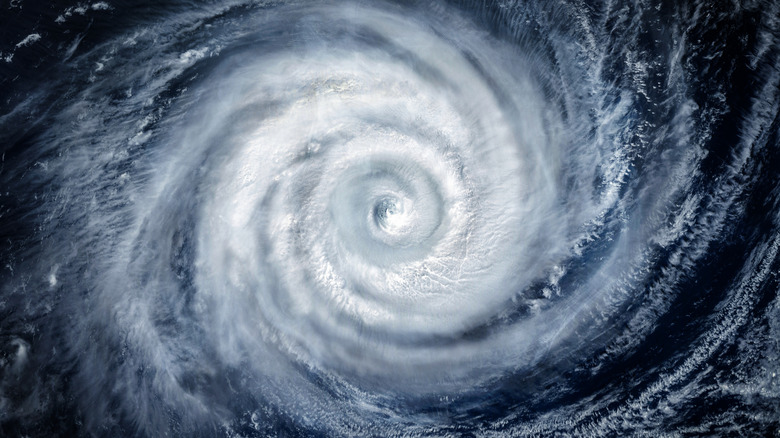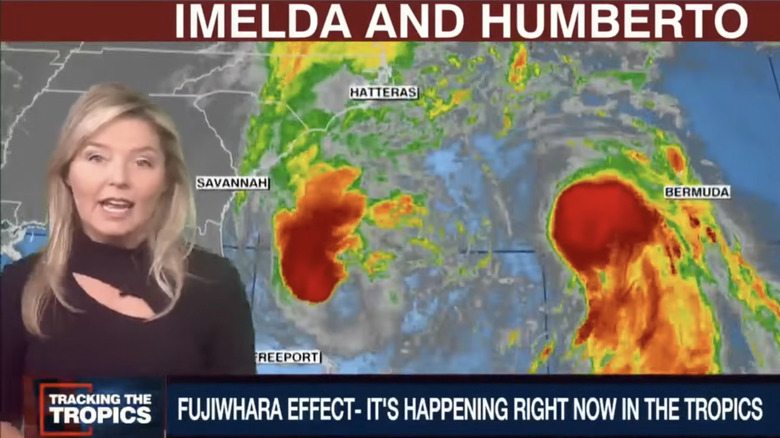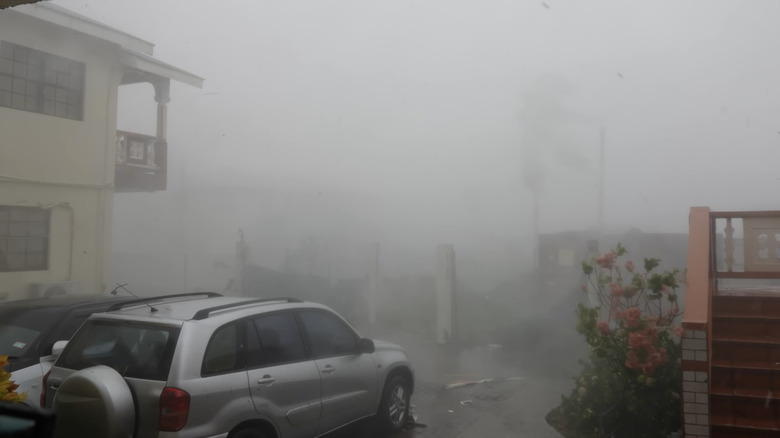This Is What Happens When Two Massive Hurricanes Clash
It's not often that two massive hurricanes find themselves in a tropical traffic jam, but the consequences can be wildly unpredictable when they get too close. This scenario played out in October 2025 in the Atlantic ocean with Hurricane Humberto and Imelda. Imelda was initially expected to hit the U.S. coast, but thanks to the influence of the stronger storm, Humberto, it actually pulled away. Both hurricanes are now expected to stay at sea.
The whole incident was due to what's known as the Fujiwhara effect, a phenomenon that kicks off when two storms get close enough to influence each other's strength and trajectory. It essentially forces the two cyclones into a duet, causing them to orbit an invisible pivot point located in the space between them. The concept was first theorized in a 1921 paper by its namesake, Japanese meteorologist Sakuhei Fujiwhara. For this tropical tango to even begin, however, the storms need to get surprisingly close, generally creeping to within 870 miles of each other.
Two storms of roughly equal strength will often orbit each other for a while before going their separate ways, though even this pulls both off their originally predicted paths. A more dramatic result occurs when one storm is significantly more powerful than the other. The larger hurricane will dominate the interaction, causing the smaller one to orbit it before being completely absorbed; the stronger storm essentially devours the weaker one. In the rarest cases, two smaller storms can actually merge. This results in the creation of one larger, more powerful storm, escalating the potential threat.
Why forecasting these storms is so difficult
Occurrences like these are a nightmare for meteorologists trying to predict where the storms will go. The Fujiwhara effect introduces a massive element of uncertainty because it can radically change a storm's expected path. This makes it incredibly challenging to provide timely warnings to communities that might suddenly be in danger. Weather calculations are sensitive enough under more normal conditions, but in such cases, even NASA's more sophisticated hurricane tracking methods get thrown for a loop.
The interaction between Humberto and Imelda was a perfect example of this. While there were landfall fears initially, those never materialized. For communities that do face landfall, having reliable gear and tools for hurricane season helps. In the case of Imelda, the storm's trajectory was influenced not just by Humberto, but also by a massive high-pressure zone sitting over the Great Lakes.
This created a dangerously fluid situation, leaving forecasters with no clear answer on the storms' final tracks. The only way they could get one is if a stronger, outside weather system intervened to force the storms apart; or if one of the hurricanes simply ran out of energy and collapsed on its own. Sometimes, in cases like these, specialized aircraft like the Hurricane Hunter jet are sent to collect in-storm data to refine forecasts.
Other famous hurricane duels
Clashes between two hurricanes aren't very common, but they aren't mythical either. The outcomes swing wildly between each occurrence. One of the clearest examples of the "dance" outcome occurred in 2017, when Hurricane Hilary and Hurricane Irwin interacted in the eastern Pacific. Hilary was the stronger of the two, and its influence stopped Irwin's westward movement, forcing it onto a northward track instead. They were well-matched enough that they spun around each other for so long, they both eventually dissolved around the same time.
The absorption scenario played out spectacularly in 2022. The powerful Typhoon Hinnamnor literally consumed a budding tropical depression in the West Pacific. This violent interaction slowed Hinnamnor down and caused it to take a sharp, nearly 90-degree turn from its original path. A similar fate befell Tropical Storm Henriette in 2001, which was eaten up fully by the more powerful Hurricane Gil. For an even rarer outcome, look to 1994; when Typhoon Pat and Tropical Storm Ruth completed a full orbital dance before finally collapsing into a single cyclone.


